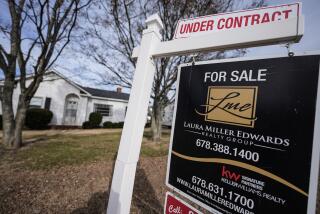Future Bright, Real Estate Brokers Told
- Share via
HONOLULU — Real estate brokers are typically those sunny types who can always find a ray of sunshine in a heavy overcast, and the ones attending the 80th convention of the National Assn. of Realtors here last week were no exception.
They even managed to find a positive fallout from Black Monday, the stock market crash of Oct. 19.
Association President William M. Moore said that the lower mortgage interest rates in the wake of the market plunge have opened a “window of opportunity” for buyers who were priced out of the housing market by the run up in mortgage rates last spring. This led to a decline in housing sales that will not be made up during the traditionally slow fall and winter months remaining in 1987, he said.
The 750,000-member trade group estimates that each percentage point in mortgage rates causes a loss of about 300,000 existing-home sales over a 12-month period. John A. Tuccillo, NAR’s chief economist, doesn’t expect a recession in either 1988 or 1989, but he said 1988 will not be as good a year for housing as either 1986 or this year. He said there should be about 3.20 million to 3.25 million existing-home sales next year, along with about 630,000 new-home sales.
The existing home pace will be off about 3.2% from the 1987 projected total of 3,316,000 sales, he said. The new home total of 630,000 will be 7.5% below the 681,000 new single-family sales projected for 1987.
Housing starts will likely reach about 1,522,000 next year, an 8.3% decline from the 1,659,000 starts projected for 1987, Tuccillo said.
Other economists addressing the estimated 25,000 persons attending the convention, headquartered at the Hilton Hawaiian Village hotel in Waikiki, generally agreed with the fairly optimistic forecasts from Moore and Tuccillo. Donald Straszheim, chief economist of Merrill Lynch Economics, called the plunge of Oct. 19 “damaging but not fatal.”
The consumer sector--including housing sales--will be affected first, if only because the recovery is in its sixth year and is very mature, he added.
No Happy Ending
“No end is in sight for solutions to either the trade or budget deficits and the economy is not even close to being in equilibrium,” Straszheim said. “This is not a scenario for a story with a happy ending.”
Charles Wurtzebach, vice president of management and investment research for Prudential Realty, indicated that the window of opportunity for domestic investors such as pension funds has included shopping centers and multifamily developments--two forms of real estate so far neglected by Japanese and other foreign investors who have gone after “trophy” downtown and suburban office buildings.
He indicated that shopping centers so far aren’t overbuilt, but this is far from the case with apartment buildings in most cities. Developers and investors in apartments would be wise to closely examine mobility patterns and demographic trends that show a sharp drop-off in the number of people typically likely to rent the apartments being produced, Wurtzebach said.
Infused With ‘New Spirit’
Addressing the crisis in the savings and loan industry, Lawrence White, a member of the board of the Federal Home Loan Bank Board (FHLBB), said that the body--the regulatory agency of federally chartered savings and loans--is infused with a “new spirit.” This is largely due to the turnover at the board level, with all three members newly appointed last year or the beginning of this year.
The main concern of the board is the Federal Savings & Loan Insurance Co. or FSLIC, the department that insures accounts in savings and loans. White said that 80% of the nation’s S&Ls; are healthy, with the other 20% either insolvent or running losses.
White called for rethinking in three areas that affect the insurance arm of the FHLBB: pricing, the equality of information and the lack of enforcement tools.
“We currently operate under a one-price policy, charging 21 cents per $100 of deposits, not a sensible way to run an insurance company,” he said. “The price of insurance should reflect the risks we face, with S&Ls; with higher capitalization paying lower rates.”
The quality of information currently received by the board and its insurance arm is not current market value data and there is currently no provision for monetary fines for infractions.
Continuing on the good news front at the convention, NAR’s economist Tuccillo said that existing home prices should rise about 4.7% nationally in 1988, from a national median price of $84,600 this year to $88,600 next year. This is down from the 5.8% increase in existing home median sales prices from the third quarter of 1986 to the third quarter of 1987, and reflects expected softness in the rapidly appreciating areas of the Northeast and the Pacific Coast.
Providence, R. I. was the unlikely appreciation champion, comparing the 1986 and 1987 third quarters, with existing median sales prices skyrocketing 37.8% from $91,900 to $126,600, according to NAR Regional Vice President Bob Kennedy, in charge of the six New England states. He attributed much of Providence’s price appreciation to its nearness to the booming Boston metropolitan area, including the high-tech firms ringing Route 128.
Hartford, Conn. was another booming market in the Northeast, with existing prices increasing 25.3% from $132,000 in the third quarter of 1986 to $164,400 in the third quarter of this year.
Orange County was the appreciation winner on the West Coast in the same period, with existing houses increasing in value 12.1%, from $149,600 to $167,700, Tuccillo said. Los Angeles recorded a 9.4% increase, from $132,900 to $145,400, while San Diego jumped 8.8%, from $121,100 to $131,700.
Highest Prices in Nation
New York State is a study in contrasts, according to NAR’s statistics. It has the metropolitan area with the highest prices in the nation--$183,000 for the New York metropolitan area, including northern New Jersey and Long Island--and the nation’s third lowest--$55,900 for Buffalo, where the median price was higher only than Grand Rapids, Mich. ($54,000) and Louisville ($53,300).
That window of opportunity cited by NAR President William Moore may be open for only a few months, because Tuccillo predicted that fixed-rate, 30-year conventional mortgages likely will reach an average of 10.7% next year, up from an average of 10.1% this year. Adjustable-rate mortgages with one-year interest rate adjustment periods will move up only marginally next year, from 8.2% to 8.3%, he said.
More to Read
Inside the business of entertainment
The Wide Shot brings you news, analysis and insights on everything from streaming wars to production — and what it all means for the future.
You may occasionally receive promotional content from the Los Angeles Times.










